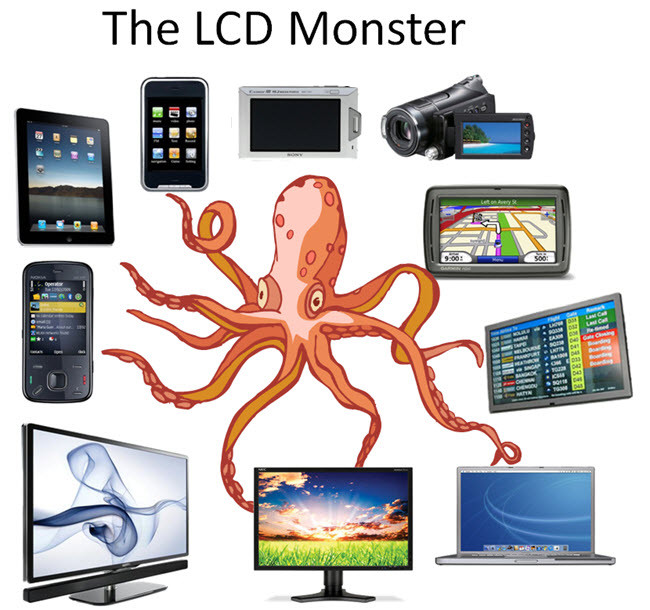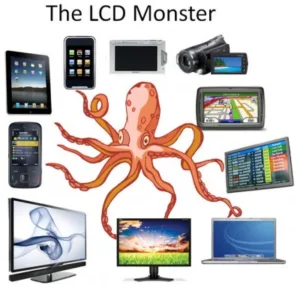
We’ve managed to get the newsletters finished slightly early this week so that the team can get the weekend off. We normally like to take a publishing break around the holiday. However, because CES will definitely mean a missed week, we’ll have small issues on the 30th December as the last issues before 13th January.
This is a time for looking back over the year. I’ll try to do a wider summary next week, but it seems to me that this year really was the year that OLED really took some very big steps towards becoming mainstream. For a number of years, I have shown a slide in presentations that showed the ‘LCD Monster’. I have included the picture here.

The point of the slide was to show how LCD basically took everything. I liked the idea of an octopus as it has tentacles that could reach everywhere. It has been incredibly hard for other technologies to find applications where they do not compete with LCD. When I have described the monster to those developing competitive and new technologies, and I explained how hard that was, they have often said “Do you know an area?”. There was often a pleading in their eyes.
However, this year, OLED has clearly taken the initiative in smartphones, which is the largest display application on a unit basis. For the first time, the two Korean giants, who are the industry leaders, have chosen to invest more in OLED than LCD and, significantly, Samsung has reduced its capacity for LCD in order to boost OLED capacity. That would have been very, very unlikely in any previous year.
So, the monster may have a weak spot. Finally, there is a mainstream application where LCD may not be the optimum solution. The challenge for OLED will be to get out of just smartphones, and tablets. LG is trying to develop OLED TV. Samsung would have done, but was too technically ambitious, so it has had to settle for pivoting its strategies to back QD-backlit LCDs. However, at the moment, almost 2,000 times more LCD TVs have been made than OLEDs (source:IHS Markit) and that has a huge impact on cost. Anybody who has seen OLED notebooks or monitors in the last year must have been impressed, I certainly was, but sales are tiny or non-existent. LCD doesn’t look under threat, yet.
There is still time for OLED to fail to get out of the smartphone/tablet/mobile device niche. PDP also competed effectively with LCD in one application, large TV, but an inability to show small pixels or achieve low power consumption eventually meant that LCD killed it. At CES, I’m pretty sure, from what I’ve heard (and as Chris said in Samsung QD TVs Could be a Game Changer) Samsung will have some very impressive LCDs. Sony has had very good reviews for its high end 65″ LCD TV, muddying the water for some who would otherwise have chosen LG’s OLEDs as, without question, the best looking TVs. So, the battle for the title of best TV will be big in Las Vegas.
For consumers, of course, the most recent top TVs are quite phenomenal, when you look at what we had just five or ten years ago. I’ll end with an old joke that I saw on an email joke list (yes, even in these days of Facebook and Snapchat, they still exist!). Some say the glass is half empty. Some say it’s half full. They are missing the point; the glass is refillable. I’m sure in 2017, the display glass will be refilled.
Have a good holiday!
Bob

